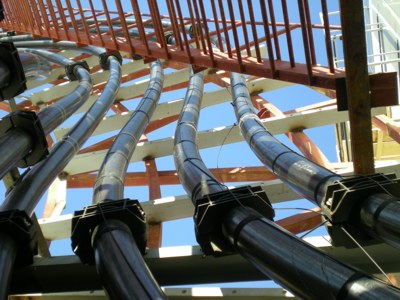Distributed Temperature Sensing (DTS) Systems for high voltage cable systems were frequently discussed in course of the recent Jicable conference, the 8th International Conference on Power Insulated Cables.
Several papers on online condition monitoring based on fibre optic temperature sensing were presented. In more papers DTS was mentioned as being part of the high voltage cable project discussed.
This slideshow requires JavaScript.
The necessity analysis of distributed fiber-optic temperature monitoring by Xiamen power cable alarm case study YAN Youxiang, SU Xueyuan – Xiamen power Ultility, Xiamen, Fujian; China XIAO Chuanqiang – SINDIA, Beijing; China
Dynamic rating of transmission cables
Erik JACOBSEN, Jonas Fabricius NIELSEN, Steen Beck NIELSEN – SEAS-NVE Holding, Haslev; Denmark Sven SALWIN – nkt cables A/S, Copenhagen; Denmark Karl-Heinz COHNEN, Andreas MOHRS – nkt cables GmbH, Köln; Germany
Real time load optimisation of cable based transmission grids Rasmus Schmidt OLSEN, Unnur Stella GUDMUNDSDÓTTIR – Energinet.dk, Fredericia; Denmark Joachim HOLBOELL – Technical University of Denmark, Kongens Lyngby; Denmark
Read more about Jicable in general:
June 2011 Versailles Congress Centre – Jicable’11 – 8th International Conference on Power Insulated Cables
What is Jicable’11?
Jicable ’11 is an international forum for the exchange of information in the fields of research, industrial development, installation, operation and diagnoses relating to insulated power cables and their accessories from low voltage and special cables up to ultra high voltage cables and cables of new technologies.
Why is Jicable’11 important?
Insulated power cables are increasingly used in electrical power transmission and distribution networks. This is due to the significant progress achieved in the development of new technologies with higher performances, and supported by increasing environmental pressure. Cables are recognised as a reliable means for the transportation and distribution of electrical energy. Jicable’11 will allow in-depth analysis of the State-of-the-Art and future perspectives : new materials, evolution in technologies, improvements in fabrication process, improvement of maintenance policies and remaining life estimation, lessons learned from service experience, dielectric phenomena, thermal and thermo-mechanical behaviour, new innovative technical solutions for high power transmission : new superconductive materials as well as a closer look at major submarine cable projects connecting High Voltage networks in many countries.
Who will be taking part in Jicable’11?
As in past Jicable conferences held in 1984, 1987, 1991, 1995, 1999, 2003 and 2007 (581 delegates from 48 countries), Jicable’11 will prove very useful to the following segments of the cable industry : researchers, engineers, decision-makers, raw materials suppliers, manufacturers, consultants, installers and users.
The following topics will be discussed:
- HV and EHV Cables Systems
- Economy and costs of Cable Systems
- Ageing, Diagnosis, Maintenance, Remaining Life Estimation and Management
- Technical challenges encountered with cable systems
- Industrial and Special Cables
- Cables, environment and sustainable development
- Design
- Testing Methods
Jicable 2011 was organized with the support of:
- S.E.E. – Société de l’Électricité, de l’Électronique et des Technologies de l’Information et de la Communication
- CIGRÉ – International Council on Large Electric Systems
- ERDF – Électricité Réseau Distribution France
- RTE – Réseau de Transport d’Électricité
- SYCABEL – Syndicat Professionnel des Fabricants de Fils et Câbles Électriques
- SERCE – Syndicat des Entreprises de Génie Électrique et Climatique
The Jicable’s Booklet
Discover the Jicable’s Booklet which contains all practical information about Jicable including registration procedures and technical programme
Download the Jicable’s Booklet
48.804570
2.120480
 LIOS Technology successfully provided an integrated thermal monitoring solution for a strategically important interconnection aerial line in Eastern Europe.
LIOS Technology successfully provided an integrated thermal monitoring solution for a strategically important interconnection aerial line in Eastern Europe.













 info@lios-tech.com
info@lios-tech.com Follow LIOS on twitter
Follow LIOS on twitter info@lios-tech.com
info@lios-tech.com